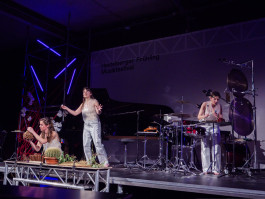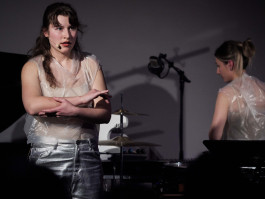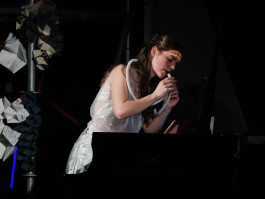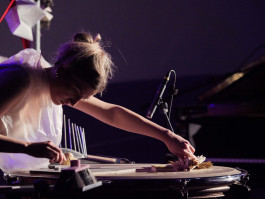humannature
Eine musikalisch-performative Studie über das Werden und Vergehen mit Liedern von Johannes Brahms
Mensch und Natur. In ihrem Projekt untersuchen drei Musikerinnen dieses Spannungsverhältnis als ein Aufeinandertreffen verletzlicher Systeme.
Bis in die tiefsten Erdschichten hinein ist mittlerweile ein dominanter geophysikalischer Einfluss der Menschheit auf das Erdsystem nachweisbar. In verschiedenen Disziplinen von Kunst und Wissenschaft wird daraus zunehmend eine neue Verantwortung des Menschen für die Zukunft des Planeten abgeleitet. Neue Narrative versuchen, den Fokus auf die komplexe Verflechtung von menschlichen und nicht-menschlichen Lebensformen zu lenken, um die langanhaltende anthropozentrische Perspektive seit der Aufklärung zu ersetzen. Vieles davon ist aber nicht gänzlich neu: Schon die Romantik wollte als erste Gegenbewegung zur Aufklärung die Welt wieder verzaubern und brachte eine Fülle von Natur-Lyrik hervor. Es war eine zentrale romantische Intuition, dass Natur noch etwas Anderes sein könne als eine Ressource, zu der sie zeitgleich in der industriellen Revolution wurde und dass besonders Lyrik das Bewusstsein für dieses ‚Andere‘ wach halten könne. Auf Grundlage dieser Lyrik entstanden einige Lieder von Johannes Brahms, von denen vier den musikalischen Ausgangspunkt der performativen Studie bilden.
Die Wahl der Musikerinnen fiel auf diese Lieder, weil sie auf unterschiedliche Weise mit der (menschlichen) Natur in Beziehung treten. In ihnen werden Landschaften und Naturphänomene zu Spiegelbildern innerer Zustände und Emotionen und erhalten eine metaphorische Bedeutung für das menschliche (Seelen-) Leben. Besungen werden Sternenhimmel, Meeresrauschen, Wasser,-Licht-und Schattenspiele; das Aufblühen und Vergehen. In einem gemeinsamen Prozess entwickelten die drei Musikerinnen das Programm weiter zu einem epochenübergreifenden Zusammenspiel von Werken, die von der Romantik bis heute die Beziehung von Mensch, Natur, Leben und Zusammenleben aufgreifen. Ihre eigenen Arrangements vereinen Lieder, Kammermusik, Improvisationen und Texte zu einem schillernden Kosmos, der sowohl mit der Vergangenheit als auch mit der Gegenwart Kontakt aufnimmt.
Das Projekt versucht nicht, auf die komplexen Fragen der Ko-Existenz von menschlichem und nicht-menschlichem Leben auf der Erde eindeutige Antworten zu geben. ‚humannature‘ ist vielmehr ein offenes Laboratorium, eine performative Studie mit Raum für Ambiguitäten und die Gleichzeitigkeit verschiedener Perspektiven.
Um die Vielfalt an Perspektiven zu erhöhen, wurden im Januar 2024 Menschen in Heidelberg durch einen Creative-Writing-Call eingeladen, ihre Gedanken zum Thema mit den Künstlerinnen zu teilen. Die eingegangenen Texte werden in einer Rauminstallation von Katharina Andes in Form von beschrifteten ‚Himmel und Hölle‘- Origami aufgegriffen, die das Publikum während des Konzertes einrahmen. Auch in der Performance tauchen einige der Texte fragmentarisch auf.
Wolke Milena Wilke, Stimme, Geige I Marlene Heiß, Klavier ITamara Kurkiewicz, Percussion
Mit Musik von Johannes Brahms, John Cage, Karlheinz Stockhausen und Rebecca Saunders
Rauminstallation: Katharina Andes I Kostüm: Wolke Milena Wilke
Eine Produktion des Heidelberger Frühling
(c) Foto: Nico Rademacher / Heidelberger Frühling




Human and nature. In their project, three musicians examine this tense relationship as a clash of vulnerable systems.
Humanity's dominant geophysical influence on the earth system can now be traced right down to the deepest layers of the earth. In various disciplines of art and science, a new human responsibility for the future of the planet is increasingly being derived from this. New narratives are attempting to focus on the complex interdependence of human and non-human life forms in order to replace the long-standing anthropocentric perspective since the Enlightenment.However, much of this is not entirely new: Romanticism, as the first counter-movement to the Enlightenment, wanted to re-enchant the world and produced a wealth of nature poetry. It was a central Romantic intuition that nature could be something other than a resource, which it became at the same time as the industrial revolution, and that poetry in particular could keep the awareness of this 'other' alive. Based on this poetry, several songs by Johannes Brahms were created, four of which form the musical starting point of the performative study.
The musicians chose these songs because they relate to (human) nature in different ways. In them, landscapes and natural phenomena become mirror images of inner states and emotions and take on a metaphorical meaning for human (soul) life. Starry skies, the sound of the sea, water, light and shadows are sung about; blossoming and fading. In a joint process, they developed the program into a cross-epochal interplay of works that address the relationship between human, nature, life and coexistence from the Romantic period to the present day. Their own arrangements combine songs, chamber music, improvisations and texts to create a dazzling cosmos that makes contact with both the past and the present.
The project does not attempt to provide clear answers to the complex questions of the co-existence of human and non-human life on earth. Rather, 'humannature' is an open laboratory, a performative study with room for ambiguity and the simultaneity of different perspectives.
To increase the diversity of perspectives, in January 2024 people in Heidelberg were invited to share their thoughts on the topic with the artists through a creative writing call. The texts received will be incorporated into a spatial installation by Katharina Andes in the form of labeled 'heaven and hell' origami, which will frame the audience during the concert. Some of the texts also appear fragmentarily in the performance.
(c) Foto: Nico Rademacher / Heidelberger Frühling




humannature
Eine musikalisch-performative Studie über das Werden und Vergehen mit Liedern von Johannes Brahms
Mensch und Natur. In ihrem Projekt untersuchen drei Musikerinnen dieses Spannungsverhältnis als ein Aufeinandertreffen verletzlicher Systeme.
Bis in die tiefsten Erdschichten hinein ist mittlerweile ein dominanter geophysikalischer Einfluss der Menschheit auf das Erdsystem nachweisbar. In verschiedenen Disziplinen von Kunst und Wissenschaft wird daraus zunehmend eine neue Verantwortung des Menschen für die Zukunft des Planeten abgeleitet. Neue Narrative versuchen, den Fokus auf die komplexe Verflechtung von menschlichen und nicht-menschlichen Lebensformen zu lenken, um die langanhaltende anthropozentrische Perspektive seit der Aufklärung zu ersetzen. Vieles davon ist aber nicht gänzlich neu: Schon die Romantik wollte als erste Gegenbewegung zur Aufklärung die Welt wieder verzaubern und brachte eine Fülle von Natur-Lyrik hervor. Es war eine zentrale romantische Intuition, dass Natur noch etwas Anderes sein könne als eine Ressource, zu der sie zeitgleich in der industriellen Revolution wurde und dass besonders Lyrik das Bewusstsein für dieses ‚Andere‘ wach halten könne. Auf Grundlage dieser Lyrik entstanden einige Lieder von Johannes Brahms, von denen vier den musikalischen Ausgangspunkt der performativen Studie bilden.
Die Wahl der Musikerinnen fiel auf diese Lieder, weil sie auf unterschiedliche Weise mit der (menschlichen) Natur in Beziehung treten. In ihnen werden Landschaften und Naturphänomene zu Spiegelbildern innerer Zustände und Emotionen und erhalten eine metaphorische Bedeutung für das menschliche (Seelen-) Leben. Besungen werden Sternenhimmel, Meeresrauschen, Wasser,-Licht-und Schattenspiele; das Aufblühen und Vergehen. In einem gemeinsamen Prozess entwickelten die drei Musikerinnen das Programm weiter zu einem epochenübergreifenden Zusammenspiel von Werken, die von der Romantik bis heute die Beziehung von Mensch, Natur, Leben und Zusammenleben aufgreifen. Ihre eigenen Arrangements vereinen Lieder, Kammermusik, Improvisationen und Texte zu einem schillernden Kosmos, der sowohl mit der Vergangenheit als auch mit der Gegenwart Kontakt aufnimmt.
Das Projekt versucht nicht, auf die komplexen Fragen der Ko-Existenz von menschlichem und nicht-menschlichem Leben auf der Erde eindeutige Antworten zu geben. ‚humannature‘ ist vielmehr ein offenes Laboratorium, eine performative Studie mit Raum für Ambiguitäten und die Gleichzeitigkeit verschiedener Perspektiven.
Um die Vielfalt an Perspektiven zu erhöhen, wurden im Januar 2024 Menschen in Heidelberg durch einen Creative-Writing-Call eingeladen, ihre Gedanken zum Thema mit den Künstlerinnen zu teilen. Die eingegangenen Texte werden in einer Rauminstallation von Katharina Andes in Form von beschrifteten ‚Himmel und Hölle‘- Origami aufgegriffen, die das Publikum während des Konzertes einrahmen. Auch in der Performance tauchen einige der Texte fragmentarisch auf.
Wolke Milena Wilke, Stimme, Geige I Marlene Heiß, Klavier ITamara Kurkiewicz, Percussion
Mit Musik von Johannes Brahms, John Cage, Karlheinz Stockhausen und Rebecca Saunders
Rauminstallation: Katharina Andes I Kostüm: Wolke Milena Wilke
Eine Produktion des Heidelberger Frühling
(c) Foto: Nico Rademacher / Heidelberger Frühling




Human and nature. In their project, three musicians examine this tense relationship as a clash of vulnerable systems.
Humanity's dominant geophysical influence on the earth system can now be traced right down to the deepest layers of the earth. In various disciplines of art and science, a new human responsibility for the future of the planet is increasingly being derived from this. New narratives are attempting to focus on the complex interdependence of human and non-human life forms in order to replace the long-standing anthropocentric perspective since the Enlightenment.However, much of this is not entirely new: Romanticism, as the first counter-movement to the Enlightenment, wanted to re-enchant the world and produced a wealth of nature poetry. It was a central Romantic intuition that nature could be something other than a resource, which it became at the same time as the industrial revolution, and that poetry in particular could keep the awareness of this 'other' alive. Based on this poetry, several songs by Johannes Brahms were created, four of which form the musical starting point of the performative study.
The musicians chose these songs because they relate to (human) nature in different ways. In them, landscapes and natural phenomena become mirror images of inner states and emotions and take on a metaphorical meaning for human (soul) life. Starry skies, the sound of the sea, water, light and shadows are sung about; blossoming and fading. In a joint process, they developed the program into a cross-epochal interplay of works that address the relationship between human, nature, life and coexistence from the Romantic period to the present day. Their own arrangements combine songs, chamber music, improvisations and texts to create a dazzling cosmos that makes contact with both the past and the present.
The project does not attempt to provide clear answers to the complex questions of the co-existence of human and non-human life on earth. Rather, 'humannature' is an open laboratory, a performative study with room for ambiguity and the simultaneity of different perspectives.
To increase the diversity of perspectives, in January 2024 people in Heidelberg were invited to share their thoughts on the topic with the artists through a creative writing call. The texts received will be incorporated into a spatial installation by Katharina Andes in the form of labeled 'heaven and hell' origami, which will frame the audience during the concert. Some of the texts also appear fragmentarily in the performance.
(c) Foto: Nico Rademacher / Heidelberger Frühling



